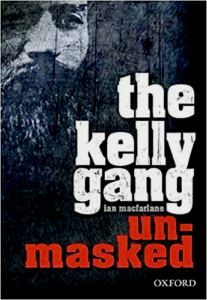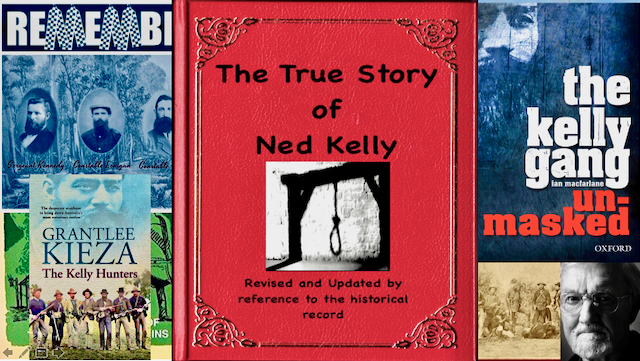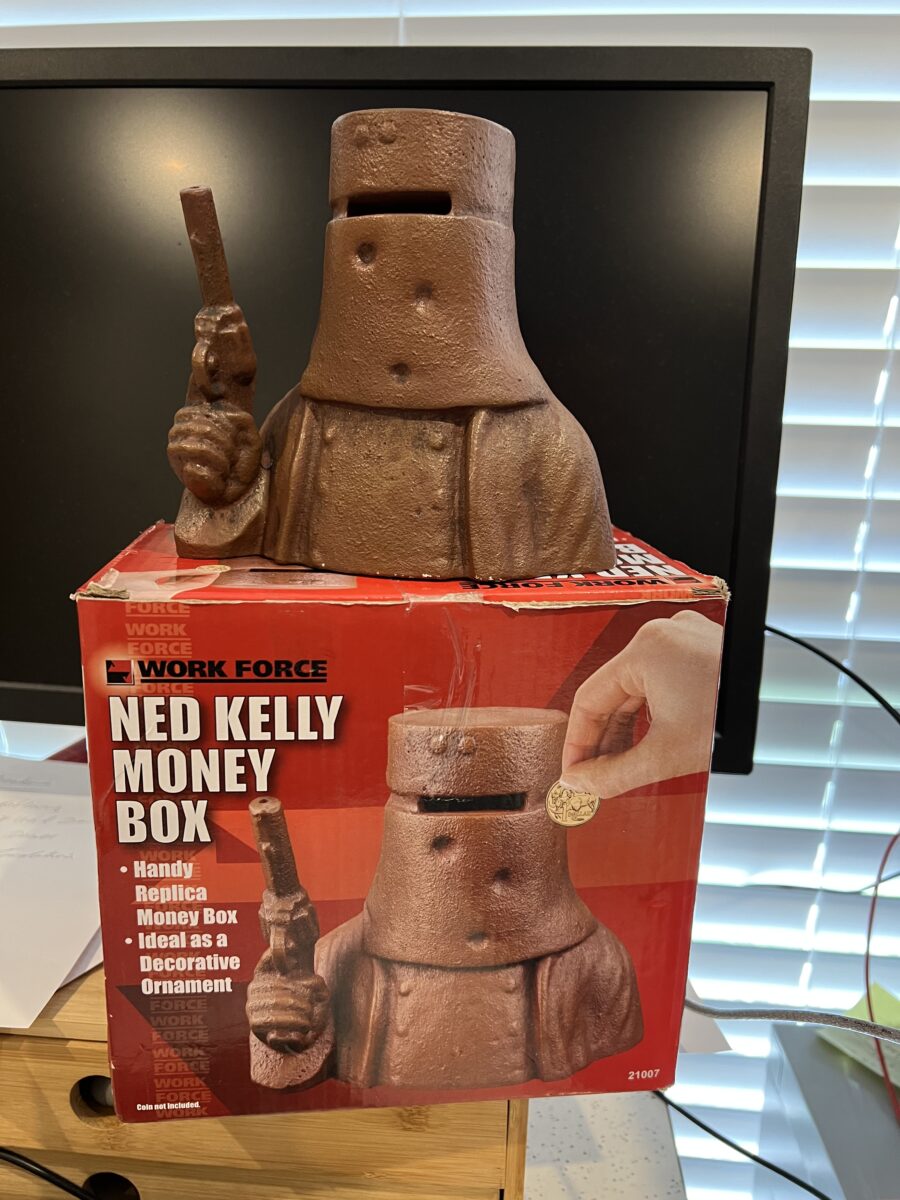Most people in Australia know something about the bush ranger Ned Kelly and would recognise the suits of armour his Gang made for themselves, but how many of them would know that in the last ten years the story of the Outbreak has undergone a radical shake-up? In this essay I briefly review the way the story has changed over the 143 years since the Kelly gang was destroyed in June 1880 and bring readers up to date with where the last decade of research has taken it to.
It’s important to understand first of all that for most of the last 143 years, Ned Kelly and the Kelly gang were almost universally considered to be notorious criminals, and nothing else. Read what an Editorial in the Singleton Argus of July 7th 1880 had to say about it :
“The destruction of the Kelly gang is a great blessing. It has spread throughout the country a sense of relief hardly expressible in words. Had society been ridded of a horde of hyenas, wolves, and tigers, thirsting for human blood, the joy would scarcely have been greater than that felt at the hunting-down of this band of unmitigated ruffians and murderers.”
The Editorial concluded with these words: “We are sure our readers will join us in the congratulations we offer this colony on the destruction of this world-renowned gang of robbers and assassins”
It took almost 50 years for a different view of the Kelly gang to begin to emerge, when James Jerome Kenneally, Unionist, Labor party candidate, school teacher and friend of Ned Kellys brother Jim, wrote and published “The Complete Inner History of the Kelly Gang and its pursuers” in March 1929. Kenneally described Ned Kelly in very positive terms, saying he was “strongly built, an excellent shot expert horseman and a good fighter”. Kenneallys narrative was that the Kellys were victims of police persecution: “It is very evident therefore that the police, metaphorically speaking intended to use LOADED DICE to rob the Kellys of their freedom”
Ned Kellys 70 year old brother Jim Kelly provided a ringing endorsement of this book, saying “You are the only author who has courage to do justice to the Kelly Gang….the people of Australia are now in full possession of the truth”
Kenneallys view of the Outbreak slowly infiltrated the discussion about the Outbreak, and awareness of it received an enormous boost from Sir Sydney Nolans famous 1948 Ned Kelly series of paintings, which still have their own special Gallery at the National Gallery in Canberra. At about the same time, author Max Brown published his influential and sympathetic “Australian Son”, other sympathetic authors followed in increasing numbers, and in 1970 Mick Jagger starred as Ned Kelly in the first colour movie about him. By the time of the centenary of Ned Kellys execution in 1980 a view was gaining ground that far from being a criminal, Kelly was in fact a ‘social bandit’, a man persecuted for challenging the way the poor and the working class were mistreated by the establishment, a man whose struggle for social justice for his family and community ended in his destruction but made him a hero. That year an enduringly popular, profoundly sympathetic and influential four-part TV miniseries called ‘The Last Outlaw’ was produced by Ian Jones and Bronwyn Binns. Genuine academic interest and historical research into this developing perspective on the Kelly story continued to grow, and the books kept coming. Writer Ian Jones emerged as ‘Australia’s foremost Kelly authority’, publishing his landmark biography “Ned Kelly: A short life” in 1995. In that work, he presented a claim about Ned Kelly that he had been developing since 1967, that at Glenrowan Kelly planned to overthrow local authorities by an act of war, and declare the North East a republic.
By the time of the Sydney Olympic Games in 2000, where dozens of representations of him on horseback, guns blazing were included in the opening ceremony, Ned Kellys status had been elevated to national icon, the exact reverse of what it had been a century before. In 2001 ‘Ned: The Exhibition’ opened and ran for nine months in Melbourne, and for the next decade it seemed as if Ned Kellys place in history as an Australian icon was assured. Annual commemorations in “Kelly country” were attended by hundreds, study materials were produced for school children, museums and galleries developed sympathetic displays and exhibitions, more films were made, more books written, web pages and Facebook pages sprang up, a Ned Kelly tourist trail was developed and almost all of it was devoted to the Legend of Ned Kelly, the new Australian hero and icon. The dominating influence of Ian Jones on all this can hardly be underestimated.
Enter Ian MacFarlane, archivist, broadcaster and writer.
His twenty-one year career as an archivist at the Victorian Public records office enabled him to become very familiar with the voluminous historical record collection relating to the Kelly Gang and the Outbreak. MacFarlane soon realised that much of the popular new mythology was directly contradicted by the archival records that he was looking at, it had moved way beyond what the evidence supported and was therefore unhistorical and needed to be corrected. In 2012, he published ‘The Kelly Gang Unmasked’ a highly praised and devastating rebuttal of the new view of Ned Kelly, that he was a hero. MacFarlane relied heavily on archival material to show convincingly that the view of him that had been overthrown 50 years earlier, that he was a violent criminal, was in fact the only view supported by the documentary evidence. This landmark book became a radical turning point in the Kelly history debates.

The tide of academic interest and of sympathetic publications stopped almost immediately, and then began to recede as piece by piece the Ian Jones inspired legend was dismantled and replaced by narratives based on the historical evidence. This process was greatly enhanced when the Public Records Office of Victoria digitised its vast collection and made it available online to everyone. A new wave of Kelly scholarship appeared, and over the next few years a dozen or more new publications appeared as the narrative was rewritten to make it faithful to the historical evidence, and the true story re-emerged.
The concept of social banditry as it had been applied to Ned Kelly was thrown out, the ‘Republic’ was shown to have been a 20th century creation that emerged out of a journalistic spoof, the ‘selector’ unrest said to have been the fertile soil out of which Kellys rebellion emerged was shown to have been vastly over-estimated, the Kelly claims of having been victims of police persecution were dismissed, Kelly clan criminality was once again exposed and a host of other components of the ‘Legend’ were modified or dismissed on the basis of what the original records showed.
At the same time as the Legend was unravelling, the cultural expressions of Kelly admiration were disappearing as well. The annual Kelly weekend at Beechworth, famous for its trial re-enactments and attended by thousands, received dwindling support, as did the elaborate Siege commemorations at Glenrowan and they both ceased. A Kelly museum was closed. Institutions like the National Museum reviewed and removed inaccurate representations of the Outbreak, the information provided to the public at Stringybark Creek was altered to better reflect the reality, the tourism model for the north-east was expanded and Kellys role in it de-emphasised. This process continues to this day.
Predictably perhaps, given the almost cult-like devotion to Ned Kelly that existed in certain quarters, these changes were resisted by a shrinking number of die-hard Kelly fans who retreated onto members only Facebook pages. Like the fringe who still believe the earth is flat, to this day they continue to attack and abuse anyone who supports the facts and the evidence based true story, rather than their now debunked claims about Kelly being a hero.
What we are left with in 2023 is a narrative that’s much closer to the true story of what happened, a story which despite the change which continues even now has nevertheless retained its colour and intrigue, a true crime story which remains fascinating and unique in the annals of the Australian story. In subsequent Posts, beginning with Kellys trial, I am going to explain why the bits that have been discarded were myths, and needed to go.

Hi David, I think that’s a great background summary of the main lines of Kelly history writing and the impact of Ian MacFarlane’s “Unmasked” book as initiating a fundamental rethinking of it and of related Australian history.
I don’t have Facebook and couldn’t care less what goes on there. I think what’s important is whether mainstream people who run councils, museums and tourist attractions understand that much of that old version of history is purely imaginative fantasy directly contradicted by historical evidence of the day.
I think most of them are amenable to rational discussion with the exception of some of those wanting to claim some direct historical link to the Kelly or “sympathiser” families who have grown up with the Jones hero myth and think that it’s imaginary importance makes them somehow special. Just like the craze for having a convict ancestor in the 1990s, something so totally removed and distant from their actual daily life that it’s jus coffee table chat.
Those are the only people worth bothering about in my opinion; people with a genuine interest in factual history and what happened way back then. Historical tourism is a big thing, but people want true facts, and to know that such and such rubbish was believed for 50 years adds to the adventure rather than subtracts from it in my view. It’s a lot of fun myth busting. There’s a whole genre of myth busting shows, and Ned Kelly is long overdue for the video myth busting treatment.
Yes Stuart youre right that the only people worth bothering about in regard to the ongoing process of returning the narrative to the true story of what happened, are people genuinely interested in understanding and recording and promoting the facts, as far as its possible to discover them.
The lunatic fringe of Kelly sycophants are not important, they readily expose themselves as truly unhinged uninformed, rather dim and often quite vile fanatics and they have no influence over anything, despite the massive amount of noise and distraction and smoke and mirrors – and lets not forget the bullying and intimidation that they engage in.
Hi David, I was wondering why all the many replicas of Ned Kelly’s armour (there are very few replicas of any of the other half-suits of armour) show the bullet dents. If someone was going to make a replica of the armour, wouldn’t they make it undented? Why add the dents? Even this resin Ned Kelly money box I picked up on a clearance sale the other day has bullet dents in its design. Is it just because the armour was recovered with the bullet dents and so the replicas show that, or is there some peculiar psychological kink that the repro bullet dents satisfy, that cause the makers and buyers to want to add that detail of a failed plan?
I was thinking about the Prof Roger Byard article “Ned Kelly tattoos – Origins and forensic implications” (Journal of Forensic and Legal Medicine 18 (2011) 276-279) in relation to this.
Is the armour a testament to failure, to capture, to surrender as Ned surrendered at Glenrowan? Is it a symbol of submission and defeat? Is the popularity of the image an acknowledgement of justice and the ultimate success of the long arm of the law?
Does the armour symbolise the defeat of a villain? Are the replica armours a kind of self-flagellation exercise, an admission that crime does not pay, a visual symbol of hopeless despair? As Joe Byrne said to Ned Kelly at Glenrowan, “this bloody armour will bring us to grief” (See Argus 21 Sept 1881). Everyone in Kellyland knows that. So why don’t they want undented replica armour?
The psychological indentification seems to be negative and self-defeatist from this angle. Similar to what Byard concluded about those who get Kelly tattoos maybe?
Attachment
Thats a great money box you got there Stuart!
I think to the Kelly fans, the dents show how tough Kelly was to have stood there and get shot at by police. What a shame one bullet didnt find the gap and blow his brains out, like Lonigans were. It would have saved a lot of stuffing around with trials and executions!
The armour is iconic, people want a replica of how it looked after withstanding the Police bullets. I have 3 of those metal money boxes, not one came with the box so we’ll done.
Thanks Dave, that overlaps with David’s thought that it displays some kind of grit under fire. And indeed it does, as Kelly advanced and drew gunfire wearing the armour; although not nearly as many bullets fired either by or at him as the popular imagination has it; no “hail of bullets”. Sharon Hollingsworth tackled that issue on her Eleven Mile Creek blog some time back, “FLASHBACK: Did They Really Fire 15,000 Rounds at the Siege of Glenrowan?”, 4 November 2018.
A related question is whether his advance toward the Inn was desperation rather than heroism. He was wounded, stuck in the armour, unable to mount a horse. His only hope was to get his armoured mates to come out and join him in a dawn bid to shoot their way out somehow. He didn’t know Byrne was dead (as I established with a total demolition of Jones ‘ theory of Kelly walking through the police line three times in armour during the night, in my Republic Myth book). Dan and Steve were useless; that’s why Ned called them cowards after his capture. And he was shot down on his way forward in that 10 minute confrontation when Sgt Steele got him in the leg with buckshot (10 minutes, posted on this blog 5 November 2018).
That led to my speculations about psychological reasons other than the ‘showing toughness’ one about why people might like a model of Kelly in shot up armour. I’m still wondering about that.
Anyway, your metal money boxes are presumably the original cast iron “NSW 1956” ones, whereas mine in the box is the resin replica made in China that sells for $25-30 in shops and online. Can’t win them all…
Further to my Ned money box being a resin Australiana replica made in China: Just like they sell made-in-China painted boomerangs, Aussie flags and kangaroo and koala toys for tourists. Fly the tourists over for sightseeing and real estate shopping tours, collected at Tulla by Chinese charter sightseeing buses, staying at Chinese operated motels and selling them made-in-China souvenirs…
Then an Australian developer buys the desired house block in sunny Camberwell (or prime Sydney or wherever), bulldozes the old house, builds the new plan to order, and voila, it’s legal as the demolition and rebuild was by an Australian developer; the new property just happens to be located where and exactly the model of what the overseas buyer wants. Truly miraculous how the character homes of the old suburbs vanish for sparkling McMansions and tower units for overseas buyers… Any council planning section folk got a finger in the pie, one wonders… Or state government pollies…
It is interesting David that you wished Ned’s brains were blown out. Yet the Senior Police right there at the time did not, even treated Ned with kindness.
My wish wasnt for someone to blow them out in cold blood after capture, but in the battle…if a bullet had gone through the eye-slot a lot of other problems would have been solved!
Your point about police treating him decently once captured is a point many sympathisers refuse to recognise because it goes against their dogma about the police being worse than the criminals and out to get him by any means.
But Kelly sympathisers have never let the facts get in the way of their ridiculous story about the murderer Ned Kelly.